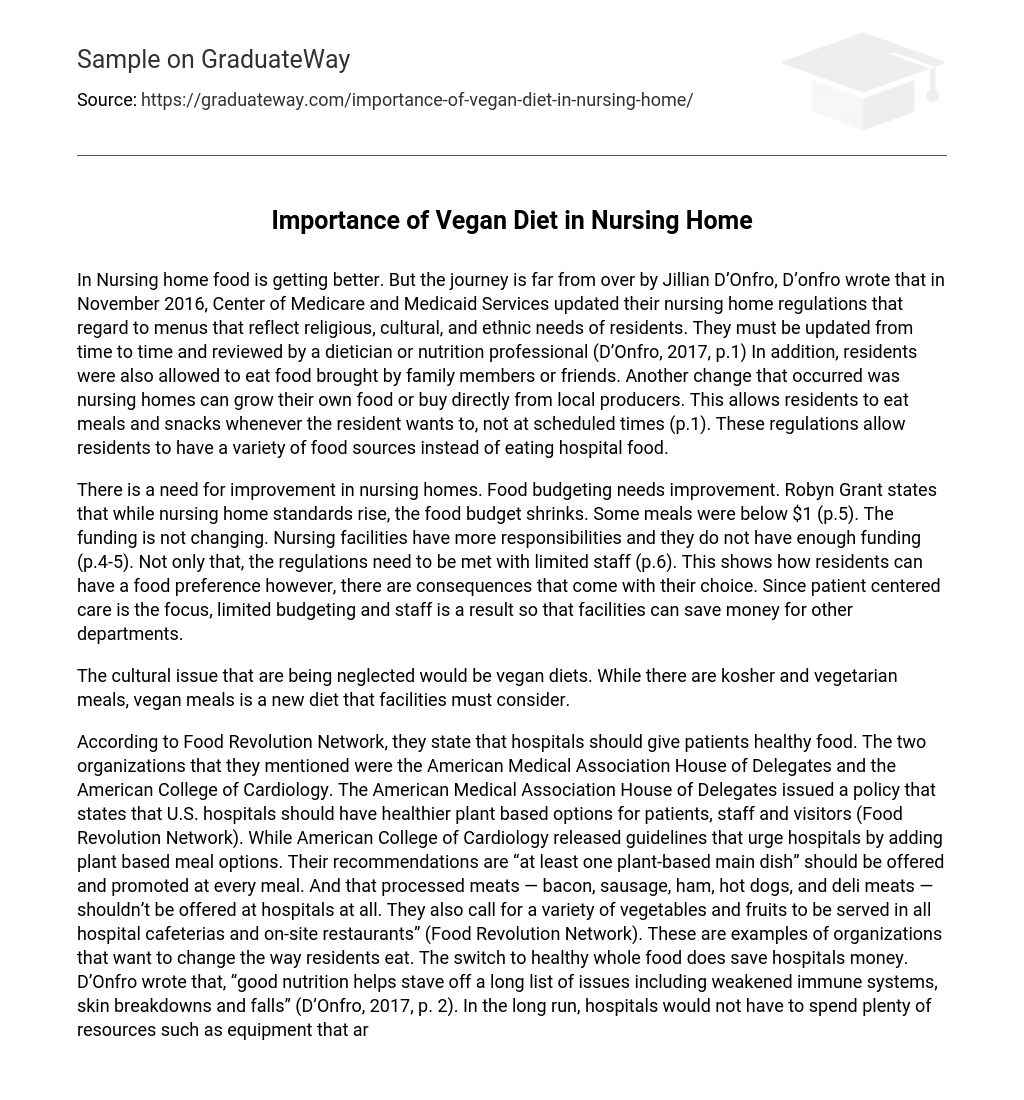In Nursing home food is getting better. But the journey is far from over by Jillian D’Onfro, D’onfro wrote that in November 2016, Center of Medicare and Medicaid Services updated their nursing home regulations that regard to menus that reflect religious, cultural, and ethnic needs of residents. They must be updated from time to time and reviewed by a dietician or nutrition professional (D’Onfro, 2017, p.1) In addition, residents were also allowed to eat food brought by family members or friends. Another change that occurred was nursing homes can grow their own food or buy directly from local producers. This allows residents to eat meals and snacks whenever the resident wants to, not at scheduled times (p.1). These regulations allow residents to have a variety of food sources instead of eating hospital food.
There is a need for improvement in nursing homes. Food budgeting needs improvement. Robyn Grant states that while nursing home standards rise, the food budget shrinks. Some meals were below $1 (p.5). The funding is not changing. Nursing facilities have more responsibilities and they do not have enough funding (p.4-5). Not only that, the regulations need to be met with limited staff (p.6). This shows how residents can have a food preference however, there are consequences that come with their choice. Since patient centered care is the focus, limited budgeting and staff is a result so that facilities can save money for other departments.
The cultural issue that are being neglected would be vegan diets. While there are kosher and vegetarian meals, vegan meals is a new diet that facilities must consider.
According to Food Revolution Network, they state that hospitals should give patients healthy food. The two organizations that they mentioned were the American Medical Association House of Delegates and the American College of Cardiology. The American Medical Association House of Delegates issued a policy that states that U.S. hospitals should have healthier plant based options for patients, staff and visitors (Food Revolution Network). While American College of Cardiology released guidelines that urge hospitals by adding plant based meal options. Their recommendations are “at least one plant-based main dish” should be offered and promoted at every meal. And that processed meats — bacon, sausage, ham, hot dogs, and deli meats — shouldn’t be offered at hospitals at all. They also call for a variety of vegetables and fruits to be served in all hospital cafeterias and on-site restaurants” (Food Revolution Network). These are examples of organizations that want to change the way residents eat. The switch to healthy whole food does save hospitals money. D’Onfro wrote that, “good nutrition helps stave off a long list of issues including weakened immune systems, skin breakdowns and falls” (D’Onfro, 2017, p. 2). In the long run, hospitals would not have to spend plenty of resources such as equipment that are used for patients’ illnesses. Examples of those who are following the healthy food program are Midland Health in Midland, Texas, Stony Brook University Hospital and University of Vermont Medical Center. Food Revolution Network wrote that at Midland Health, hospital chefs collaborate with registered dieticians to create whole plant based meals that feel more like cuisine from finer hotels” (Food Revolution Network). Stony Brook University Hospital has a 2,242 square foot organic rooftop that supplies vegetables and herbs for patients’ meals (Food Revolution Network). University of Vermont Medical Center give residents the option to order food when they want it and the food that they offer are nutrient dense, minimally process and locally produced ingredients (Food Revolution Network). The vegan diet that people are now demanding can affect their choice of where they want to retire. The Vegetarian Resource Group is a source that vegans can use to decide where they would retire. While nursing facilities do have a strict budget to follow, the patient’s nutrition is not something that should be compromised since their health and safety is what matters.
References
- (2017). Could the Future of Hospital Food Be Healthy, Plant-Based, and Delicious? Food Revolution Network. Retrieved from https://foodrevolution.org/blog/healthy-plant-based-hospital-food/
- D’Onfro, J. (2017). Nursing home food is getting better. But the journey is far from over. The New Food Economy. p.1-7
- Helman, S., Mangels, R., Stahler, C., Wasserman, D., Vegetarian and Vegan Options in Senior Independent Living, Assisted Living, Nursing Home, and Other Senior Facilities. The Vegetarian Resource Group. Retrieved from https://www.vrg.org/seniors/senior_vegan.php





